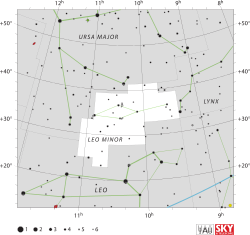
Back Beta Leonis Minoris AST Beta del Lleó Menor Catalan Beta Leonis Minoris Spanish Beta Leonis Minoris French Beta Leonis Minoris ID Beta Leonis Minoris Dutch Beta Leonis Minoris Polish Beta Leonis Minoris Portuguese Бета Малого Льва Russian Beta Leonis Minoris Swedish
| Observation data Epoch J2000.0 Equinox J2000.0 (ICRS) | |
|---|---|
| Constellation | Leo Minor |
| Right ascension | 10h 27m 53.000s[1] |
| Declination | +36° 42′ 25.96″[1] |
| Apparent magnitude (V) | 4.21 (4.40/6.12)[2] |
| Characteristics | |
| Spectral type | G9III[3] |
| U−B color index | +0.64[2] |
| B−V color index | +0.90[2] |
| R−I color index | +0.46[2] |
| A | |
| Spectral type | G8III-IV[2] |
| B | |
| Spectral type | F8IV[2] |
| Astrometry | |
| Radial velocity (Rv) | 8.52[4] km/s |
| Proper motion (μ) | RA: −127.68[1] mas/yr Dec.: −110.31[1] mas/yr |
| Parallax (π) | 21.19 ± 0.50 mas[1] |
| Distance | 154 ± 4 ly (47 ± 1 pc) |
| Absolute magnitude (MV) | +0.85[4] |
| Orbit[5] | |
| Period (P) | 13,965±40 |
| Semi-major axis (a) | 0.3782″±0.0007″ |
| Eccentricity (e) | 0.680±0.002 |
| Inclination (i) | 81.4±0.1° |
| Periastron epoch (T) | 2451411.1±4.8 JD |
| Argument of periastron (ω) (secondary) | 215.7±0.2° |
| Semi-amplitude (K1) (primary) | 7.93±0.05 km/s |
| Semi-amplitude (K2) (secondary) | 12.32±0.18 km/s |
| Details | |
| A | |
| Mass | 2.98±0.10[5] M☉ |
| Radius | 9.4±0.3[5] R☉ |
| Luminosity (bolometric) | 50.7±1.8[5] L☉ |
| Surface gravity (log g) | 2.85[4] cgs |
| Temperature | 4,097±927[5] K |
| Metallicity [Fe/H] | +0.09[4] dex |
| Rotational velocity (v sin i) | 2.54[4] km/s |
| Age | 1.2[4] Gyr |
| B | |
| Mass | 1.92±0.04[5] M☉ |
| Radius | 3.7±1.5[5] R☉ |
| Luminosity (bolometric) | 9.1±4.1[5] L☉ |
| Temperature | 5,211±843[5] K |
| Other designations | |
| Database references | |
| SIMBAD | data |
Beta Leonis Minoris, Latinized from β Leonis Minoris, is a binary star in the constellation of Leo Minor. It has an overall apparent visual magnitude of approximately 4.2. Although it is the only star in Leo Minor with a Bayer designation, it is only the second brightest star in the constellation (the brightest is 46 Leonis Minoris).[8]
- ^ a b c d e Van Leeuwen, F. (2007). "Validation of the new Hipparcos reduction". Astronomy and Astrophysics. 474 (2): 653–664. arXiv:0708.1752. Bibcode:2007A&A...474..653V. doi:10.1051/0004-6361:20078357. S2CID 18759600.
- ^ a b c d e f g HR 4100, database entry, The Bright Star Catalogue, 5th Revised Ed. (Preliminary Version), D. Hoffleit and W. H. Warren, Jr., CDS ID V/50. Accessed on line October 1, 2008.
- ^ Keenan, Philip C.; McNeil, Raymond C. (1989). "The Perkins Catalog of Revised MK Types for the Cooler Stars". The Astrophysical Journal Supplement Series. 71: 245. Bibcode:1989ApJS...71..245K. doi:10.1086/191373. S2CID 123149047.
- ^ a b c d e f Deka-Szymankiewicz, B.; Niedzielski, A.; Adamczyk, M.; Adamów, M.; Nowak, G.; Wolszczan, A. (2018). "The Penn State - Toruń Centre for Astronomy Planet Search stars. IV. Dwarfs and the complete sample". Astronomy and Astrophysics. 615: A31. arXiv:1801.02899. Bibcode:2018A&A...615A..31D. doi:10.1051/0004-6361/201731696. S2CID 85526201.
- ^ a b c d e f g h i Cite error: The named reference
Wang2020was invoked but never defined (see the help page). - ^ Entry 10279+3642, The Washington Double Star Catalog Archived 2008-04-13 at the Wayback Machine, United States Naval Observatory. Accessed on line October 1, 2008.
- ^ HD 90537 -- Spectroscopic binary, database entry, SIMBAD. Accessed on line October 1, 2008.
- ^ Cite error: The named reference
kalerwas invoked but never defined (see the help page).
